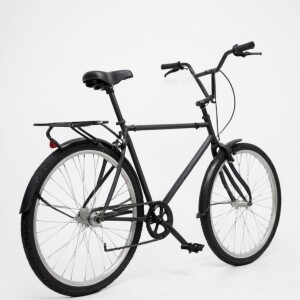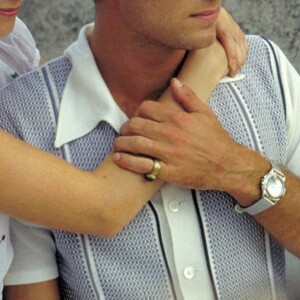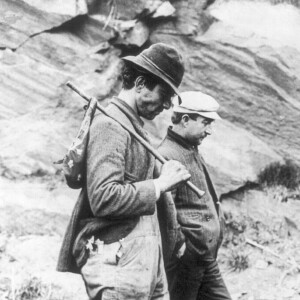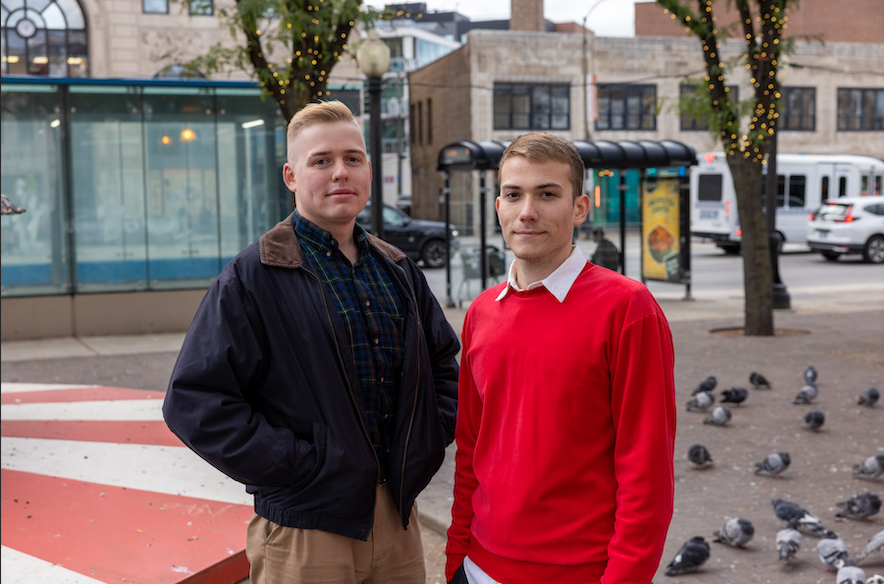Silent Generation
Silent Generation is a Chicago-based cultural analysis podcast that surveys the cultural consequences of car-oriented development in the mid-20th century. It explores what was lost between the Silent Generation and Generation Z, pointing to negative outcomes (nihilism, regional homogeneity, and low-trust societies) and potential antidotes (subcultures, secular social movements, and moral codes). Topics discussed include aesthetics, fashion, history, and urbanism. Find us on Instagram: silent.generation
Episodes

Tuesday Jun 04, 2024
Tuesday Jun 04, 2024
On this week’s episode Joseph and Nathan examine sportswear worn by both athletes and their fans. Episode 14 of Silent Generation already covered Olympic sports, so this week’s episode focuses on major league sports. They cover each of the following: baseball, basketball, football, golf, hockey, and soccer (plus rugby, road cycling, and tennis for good measure). Amongst other things they discuss how White Sox players briefly wore shorts in the 1970s, how rappers popularized hockey jerseys in the 1990s, how cyclists were depicted in The Triplets of Belleville, and how coaches (like Tom Landry and Pat Riley) dressed better prior to league-wide contracts.
Links:
Sportswear Pinterest Board
American Apparel’s Poly Mesh Football Jersey
Gay baseball raglan meme 1, Gay baseball raglan meme 2
How Hockey Jerseys Became Standard Wear for Fans
When a Sweater Defined One of the Best Rivalries
The Rise Of Athleisure In The Fashion Industry And What It Means For Brands
Artwork:
John Stockton
Recorded on 6/2/2024

Wednesday May 29, 2024
Wednesday May 29, 2024
Why has the general public been skeptical of nuclear energy, seemingly even before the technology existed? Joining the boys on this week’s episode of Silent Generation is Madison Hilly, founder and director of the Campaign for a Green Nuclear Deal, to discuss how the discourse around nuclear energy has been heavily influenced by its depictions in popular culture. They examine The China Syndrome, The Simpsons, Teenage Mutant Ninja Turtles, and Chernobyl (2019) to examine how erroneous depictions of nuclear waste and nuclear meltdowns have fomented fear. Amongst other things they talk about when Madi went viral for taking a picture next to nuclear waste while pregnant, how the baby boomer strain of environmentalism leans more “conservationist,” why nuclear waste and slime in childrens’ media is always depicted as being green, and how left wing opposition to nuclear energy seems to come from subconscious fears that radioactive material isn’t “natural.”
Links:
The Campaign for a Green Nuclear Deal
Madison Hilly’s Twitter
Pregnant Woman Poses With 'Nuclear Waste' To Prove Point About Radiation (Newsweek)
By the Waters of Babylon by Stephen Vincent Benét
Cornelia Hesse-Honegger’s Mutations
Science Behind Science Fiction: How do Teenage Turtles become Mutant Ninjas?
Studies Show That, As We Age, Our Ability To See Vivid Colors Decline
Holtec reports “remarkable progress” towards restart of Palisades
Artwork:
Nuclear power plant LCCN, Library of Congress's Prints and Photographs division
digital ID highsm.13019, CC0
Recorded on 5/26/2024
![Ep. 25: Moral Codes [TEASER]](https://pbcdn1.podbean.com/imglogo/ep-logo/pbblog17628020/La_scuola_di_Atene_pchm3e_300x300.jpg)
Tuesday May 21, 2024
Tuesday May 21, 2024
Full episode available on Patreon: https://www.patreon.com/SilentGeneration
Many parents today tell their children to simply “be a good person” and do not offer them moral guidelines beyond that. “Being a good person” isn’t a robust enough moral framework to deal with the complexities of everyday life, so many people resort to creating their own moral codes (either completely independently, or through the help of internet gurus like Jordan Peterson). On this week’s episode of Silent Generation, Nathan and Joseph reflect on their own moral codes and talk about the origins and justifications of the rules they’ve made for themselves. Amongst other things they discuss how gay culture doesn’t offer gay men a moral framework, how you should aim to be contrarian only 50% of the time, how the public has become tired of plotlines that deal with moral gray areas, and how modern Hollywood has only offered the public antiheroes in place of actual heroes.
Links:
Jordan Peterson - Are You a Good Person?
The Epidemic of Gay Loneliness
Artwork:
The School of Athens by Raphael
Recorded on 5/19/2024

Monday May 13, 2024
Monday May 13, 2024
As previously noted, Nathan has a general aversion to bikes and bike infrastructure. But where does his “bike skepticism” come from, and why do many other Americans feel the same way? On this week’s episode of Silent Generation Joseph gets to the root of Nathan’s bias (the temperament of cyclists, tacky bike lane infrastructure, and the “aesthetics of control”) and makes the case for bike-oriented cities. Amongst other things they discuss how most Americans approach biking from a sports angle, the way streets were shared by multiple transit modes in the early 20th century, how biking becomes less viable in the Winter, and how Los Angeles has the potential to become America’s foremost biking city.
Links:
The new Silent Generation Patreon!
San Francisco streetcar footage from a hundred years ago
Years and Years by Russell T Davies
On Adam Levine's tattoos
Why Many Cities Suck (and Los Angeles Doesn't Have to)
Strong Town’s idea of “complex vs. complicated”
Artwork:
AI generated
Recorded on 5/12/2024

Wednesday May 08, 2024
Wednesday May 08, 2024
In Western culture men often wear little to no jewelry, often opting to only wear a wedding ring and/ or a watch. What meaning can be discerned from the jewelry that Western men do wear and why don’t they wear more? On this week’s episode of Silent Generation the boys begin by discussing the form and function of the types of jewelry men most commonly wear: rings, cufflinks, tie pins, watches, necklaces, and belt buckles. Amongst other things they discuss the popularity of pearl jewelry amongst male queerbaiters, when men’s jewelry becomes a red flag, why wearable tech lost its potential to be considered jewelry, Nathan’s time working in the jewelry industry, and how millennial pink was a stepping stone into alternative fashion for preppy people in the late 2010s.
Links:
Rings & Their Meaning by Gentleman’s Gazette
Fran Lebowitz wearing Calder cufflinks in Scorsese’s “Pretend It’s a City”
how’d you know im uncut meme
“I got court” starterpack meme
Artwork:
Screenshot from The Talented Mr. Ripley
Recorded on 5/5/2024

Wednesday May 01, 2024
Wednesday May 01, 2024
On this week’s first ever sequel episode the boys are joined by Shan Beaste, best known by her stage name Zombelle, who was one of the co-creators of the Seapunk movement and aesthetic. As detailed in episode 12, Seapunk (2011-2014) was a ‘90s inspired aquatic subculture that Nathan participated in during high school. Zombelle recently re-released her seminal seapunk album Tropicult (remastered by Myrrhkaba) which fortuitously led to her and Nathan connecting over Instagram and spurred this week’s episode. In this reexploration of seapunk, Shan and the boys discuss Shan’s early musical history and life story, confirm that she coined the term slimepunk, reiterate the place of mermaids in seapunk culture, attribute the idea of the “internet subculture formula” to Zombelle, and speculate what second wave seapunk (or “seapunk 2”) could look like.
Any former (or current) seapunk listeners are encouraged by Shan to send testimonials, photographs, or other ephemera from Seapunk’s existence to seapunkpreservationsociety@gmail.com for an impending book she is writing on seapunk’s history!
Links:
Zombelle’s SoundCloud
Zombelle’s Instagram
Zombelle’s Seapunk Spotify playlist
The Mainframe.im Instagram page
The seapunk Wikipedia article
Don't Call It #Tumblrwave
The Complete CORAL RECORDS INTERNAZIONALE catalog from archive.org
Random Aesthetic Generator
New miracle weight loss drug! by Praefoco21
Artwork:
Provided by Zombelle
Intro song:
Bad Creation by Zombelle
Recorded on 4/28/2024

Saturday Apr 27, 2024
Saturday Apr 27, 2024
Americans generally travel domestically in four ways: road trips, air travel, train travel, and boat travel. The boys start by sharing anecdotes about their experiences with each type of domestic travel; Joseph says that he traveled for free on military aircraft as a child and Nathan shares how he grew up in a house with a boat in the backyard along the Chicago river. They then question if Americans prioritize cost, convenience, or culture when making decisions on how to travel both domestically and abroad. Amongst other things they discuss Joseph’s recent bachelor party road trip, national parks attendance, the Indiana Dunes, the South Shore Line, the Catskills, and RVs.
Links:
Top 10 Places to Build High Speed Rail In the U.S. by CityNerd
Run Lola Run
why would i fly it's only a 14 hour drive
Notorious Gridlock of Colorado's I-70 (Upzoned Episode)
Colorado’s I-70 Has America’s Most Notorious Ski Traffic. Is There a Solution? by Gloria Liu
This Town Was Paradise, Then Everyone Started Working From Home (VICE documentary)
Artwork:
Meeting the train, 1954 by Ross Orr
Recorded on 4/24/2024

Monday Apr 15, 2024
Monday Apr 15, 2024
Trailers for Alex Garland’s Civil War have tantalized the general public (and the hosts of Silent Generation) for months with scenes of explosions and themes of political polarization. This weekend the movie debuted as the #1 film in the nation, being the first A24 film to do so. On this week’s episode of Silent Generation the boys are joined by their friend Patrick to discuss the film and share personal theories of what a second civil war in America would look like. Amongst other things they discuss journalism, horseshoe theory, the role of sanctions in a second civil, Texit/ Calexit, and finally whether or not they personally support the idea of a national divorce.
Links:
Civil War trailer
The Sound of Silence by Alfredo Jaar
Richard Mosse’s photography
Introducing the Idea of Hyperobjects
Is CIVIL WAR Looming? ft. Kim Iversen
Anthropology and Counterinsurgency by Montgomery McFate
Recorded on 4/14/2024

Thursday Apr 11, 2024
Thursday Apr 11, 2024
This week Joseph and Nathan discuss an American cultural figure that can be found at the cross section of many themes thus far covered in Silent Generation: the early 1900s, train travel, ethical codes, and situational homosexuality. Hobos are perceived as yesteryear’s equivalent of the modern homeless person but they were vastly different, hobos were migrant workers with a complex system of rules and cultural values. During the episode the boys pay particular attention to hobo landmarks in Chicago such as West Madison Street, Bughouse Square, and Ben Reitman’s hobo college. Amongst other things they discuss Kitt Kittredge, the umwelt, how the word “gay” originated from hobo slang, The Dawn of Everything, and crust punks.
Links:
Hobos, Wandering in America, 1870-1940 by Richard Wormser
On Hobos and Homelessness by Nels Anderson
The Damndest Radical by Roger A. Bruns
The Hobo Ethical Code
The Case Against Travel by Agnes Collard
Alex Kaschuta’s tweet about stigmatization
Death of the American Hobo - VICE
Welcome to Oogleville by Gordon Lamb
Artwork:
This photograph (from 1870 - 1930) is from the George Grantham Bain collection at the Library of Congress. There are no known copyright restrictions on the use of this work.
Recorded on 4/8/2024

Monday Apr 01, 2024
Monday Apr 01, 2024
Electroclash is a musical genre that was most popular from 1999 to 2005 and is described as being a 50/50 mixture of electronic and rock music with an ‘80s bent. Unlike prior electronic genres, live singing, dancing, and stage performance were deployed by electroclash musicians who wanted to channel the theatricality and sex appeal of 1980s rock stars. To help explore the genre Joseph and Nathan are joined by Maya, also known as Mayalabae, a Chicago native who is now a DJ in Montreal. They begin by playing four of the biggest hits to come out of Electroclash and then identify common characteristics across the genre. Amongst other things they discuss Nathan’s favorite song as a child, Fischerspooner’s lecture at SAIC, the normie lows of the mid-2000s, the documentary Clash of Cultures: The Rise of the New Electro Scene, Liquid Sky (1982), and Lady Gaga’s accidental actualization of the electroclash agenda.
Links:
Maya’s Electroclash Playlist
Nathan’s Electroclash Playlist
Clash of Cultures: The Rise of the New Electro Scene (2002)
Liquid Sky (1982)
Party Monster (2003)
Get Happy by Happy Thought Hall
Electroclash: A Brief Cultural History
Artwork:
Screenshot of Miss Kittin from Clash of Cultures: The Rise of the New Electro Scene
All song clips used in this episode are claimed as fair use
Recorded on 3/30/2024

Joseph & Nathan
Joseph (left) grew up in Las Vegas and works in construction management. Nathan (right) grew up in Chicago and works as a librarian.
Contact us with any questions or suggestions at:
silentgeneration.chi@gmail.com










